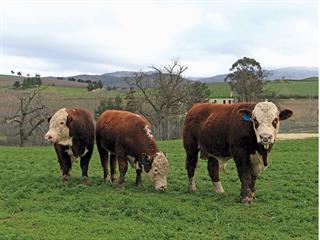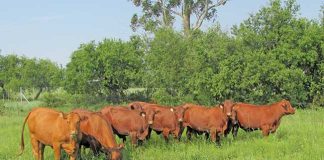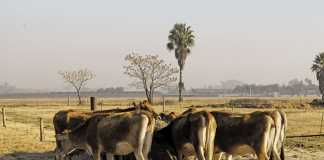
Although various ways of evaluating the performance of an animal are available, Bertus Mong does not want to debate which is the best. However, he advises all stud breeders to use these tools to improve the performance of their herds.
“As stud farmers, we must aspire to continually produce more efficient animals by positively changing the genetic merit of the next generation,” he explains. “In other words, we need to produce genetic prototypes with better feed conversion, a higher slaughter percentage and better quality meat. In this way, any genetic advance in a stud herd will benefit producers and consumers, as it helps to increase food security by enabling cattlemen to produce more beef on the same area of land.”
The benefits of using performance evaluation to guide breeding decisions are starting to pay off in many breeds in both the beef and dairy sectors. According to Prof Japie van der Westhuizen, manager of production recording at SA Stud Book, the genetic merit for feed conversion ratio (FCR) in the Hereford has improved by an average of 3,4g feed/ kg body weight gain per birth year. This translates to an average gain of 34g/ kg over the past 10 years.
Although it seems trivial, Japie says that this change equates to 5,1kg less feed needed per total weight gain of each animal in a feedlot at the same gain and finishing period. Based on available figures, approximately the same total gain can be achieved in feedlots in South Africa with 28 000t less combined feed use per year at no extra effort or cost.
Japie explains that estimated breeding values (EBVs) are indicators of the genetic merit for specific traits in animals. The heritability of these traits differs. For example, the heritability for milk yield in Jersey cows is 35% but reproductive heritability is 4%. In addition to these transmissable genetic effects, there are environmental effects. For this reason, it is a less reliable reflection of the genetic merit, and therefore of progeny performance, of these measured animals.

Bertus Mong
However, a high EBV for a specific trait means there is a good chance that most of the progeny will also excel in this trait.
“Even the best bull can sire a poor calf now and again. With a superior estimated breeding value, the chance of this happening is slim, however,” Japie says.
The genetic makeup of the calf is equally influenced by the dam, and the dam exerts further influence by being part of the calf’s environment from birth to weaning. The sire and dam each contributes 50% to the genetic make-up of each of their progeny. Using a sire with an excellent breeding value for a specific trait and a dam with a low value for the same trait might, therefore, not improve this trait in the progeny of these “poorer” cows. Nevertheless, with proper selection, their offspring will be better in this trait, on average.
While an animal might not fulfil its genetic potential under certain environmental conditions, Japie says that a highly efficient animal will always outperform an inferior animal that is also not adapted to that environment. Cattlemen should therefore buy animals suited to their specific production environments. “If you know that forage is limiting in your area, it may be better to breed cattle with smaller frames,” he advises.
A farmer’s experience
Bertus has become well-known for his award-winning animals since establishing the BM Hereford Stud in 1983 on one of his farms, Florina, near Villiersdorp. In 1991, he became one of a handful of Western Cape cattlemen to win the ARC-ABSA Inter-race Phase C Bull award with the bull BMH B00 27. Three of his cows have won a Farmer’s Weekly-ARC Best Elite Cow of the Year Award since 1985.
The stud herd consists of 120 cows and three to four bulls. He sells between 30 and 40 bulls annually. Bertus has been using best linear unbiased prediction (BLUP) breeding values as a selection tool for over 30 years and identifies this as one of the reasons for his success.
“Where cattlemen in the past had to judge the breeding potential of an animal on its physical appearance alone, production recording has led to breeding values for specific genetic traits,” he explains. “These, among others, influence feed conversion, growth efficiency, milk production, reproduction and the quality of meat. This has effectively taken a lot of the guesswork out of breeding.”
Bertus’s perseverance with BLUP has more than paid off. For example, it has improved the FCR of the stud from 6,3kg feed per kilogram meat produced to 4kg feed per kilogram produced. The genetic level for feed conversion ratio of his herd is 112 (in such calculations, the breed average is set at a value of 100). Average genetic merit for growth in the stud is 113 and the growth rate relative to maintenance, therefore growth efficiency, is 112.
Physical size and FCR
“Some breeders felt that the frame of a typical Phase C bull was too large,” he recalls. “But production recording over time in my herd revealed a direct relationship between feed conversion ratio and the depth and length of an animal. The deeper and broader the chest, the better its feed conversion ratio.”
Genetic improvement should never be at a cost of fertility or reproduction, as a decline in these traits will cost a cattleman money. Bertus says that milk production has always been a priority for him, but increasing milk production can have a negative impact on the quantity of beef produced. By careful selection, he has managed to elevate the generic merit of milk to 104 and the pre-weaning calf growth rate to 114 without adversely affecting other traits, including reproduction, that influence beef production efficiency.
Bertus uses the Livestock Operational and Genetic Exchange Programme (Logix) database linked to his mating programme to help identify bulls that would be most suitable in the breed. The programme identifies bulls with the most desirable breeding values for the traits he wants to enhance in his stud, while also informing him of the percentage inbreeding a specific mating would result in.
Inbreeding usually leads to fertility and reproduction problems, but it is not a problem on his farm. Bertus says that the Hereford is a large breed consisting of many thousands of breeding animals across the world. The danger of inbreeding is therefore lower than in the dairy industry, where fewer bulls are used and the gene pool is far smaller.
Greater accuracy
Where the accuracy of all the breeding values in his stud herd was only around 50% when he started out, it has since increased to more than 90%. Specific accuracy values that were initially low have also increased over this time. To Bertus, this illustrates that the predictions were correct even with limited herd information. A higher prediction accuracy is due to greater participation in production recording by fellow breeders, more accurate recordings and accurate pedigree records. This serves as a guarantee, he stresses.
“When I sell an animal, it means I can say with confidence that this animal has the ability to do what the breeding values predict,” he explains. “In contrast, when buying a random bull, a cattleman has no idea of what its impact on his herd will be. He might look at the performance of its peers as an indication, but this is still not as reliable as testing the bull on its own merit.”
Phone Bertus Mong on 082 841 4914.
Phone Dr Japie van der Westhuizen on 082 331 9923 or email [email protected].













